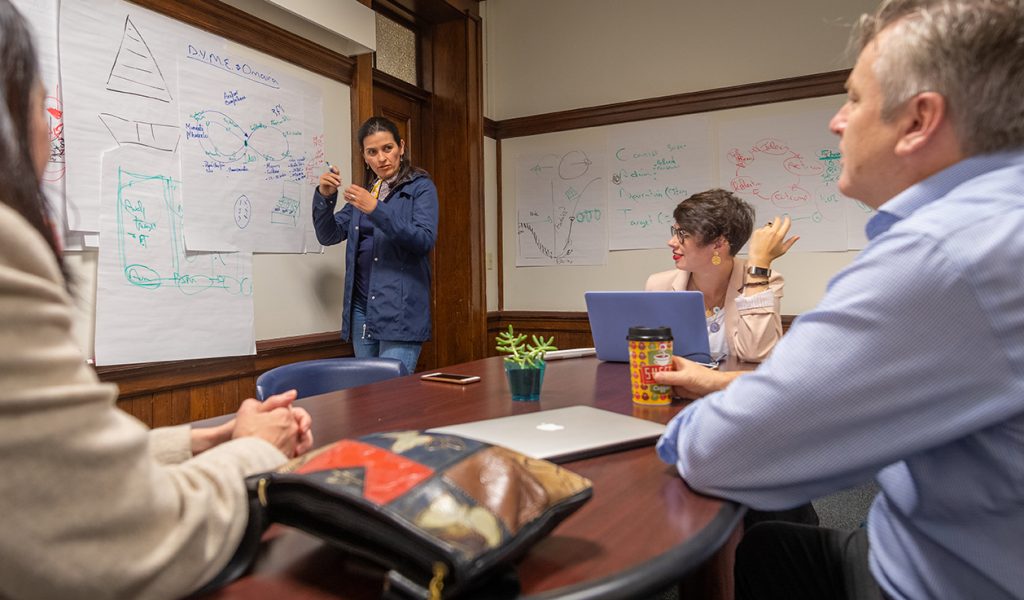Entrepreneurship professor John Dobson motivates his students to get down to business

John Dobson has been teaching the how-tos of entrepreneurship for many years, including as an associate professor of practice in the Graduate School of Management since 2014. But a few years ago, something began gnawing at him.
“I taught a theory-based, write-a-business-plan type of course, and at the end of a semester my students were less entrepreneurial than they were at the beginning of the semester,” he says. “There was a disconnect: They would present a great business plan to earn an A in the course, but when you asked them, they’d say, ‘Well, I’m not going to [start a business] right now.’ ”
Dobson decided to switch his teaching method to a hands-on, learn-by-doing approach whereby students would develop and launch a business as part of the course. That did the trick.
“I needed to focus on motivation,” he says. “Now students are required to identify a problem on campus that they want to solve. Then they spend the semester attempting to solve that problem via weekly assignments. Students take ownership about what they want to learn and how they learn it, and we switch from ‘sage on the stage’ to facilitating and guiding them as they’re trying to learn about entrepreneurship.
“The first time I taught like this it was very scary for me because I didn’t know what the outcome would be,” he continues. “I had to trust the students and trust the process. After I taught it a second time, I got more comfortable. By the third time, the outcomes were much better. I had so many students pestering me afterwards, wanting to continue with their business, that I had to develop a student-run venture course. Now, I have students like Trevor Tarnowski ’20 and Hector Miron ’18 who are running their own businesses. There’s a whole list of them.”
Dobson has also been taking Clark students on annual summer excursions to Colombia for what he describes as an “international social entrepreneurship experience.” This year, they worked with a nongovernmental organization to help women improve their families’ nutrition while developing income-generating opportunities.
During his trips abroad, Dobson frequently attends conferences where he connects with business faculty at local universities and offers workshops on how to teach entrepreneurship. After curbing his travel to spend more time with his family, he decided to try hosting a “teaching and learning entrepreneurship” workshop on the Clark campus for international faculty. He received inquiries from around the world, and held the first workshop from Sept. 27 to Oct. 4.
One attendee, Omaira Martínez Morena, research professor at Universidad Autónoma de Baja California in Mexico, noted that although small businesses play a significant role in the Mexican economy, they are usually started by older adults. To get younger people on the entrepreneurial track, the Mexican government now requires all university students to take a course in entrepreneurship. Nonetheless, students in her courses rarely try to start their own businesses, she acknowledged.
Another workshop participant, Maria C. Angel Ferrero, professor of entrepreneurship and finance at France’s Montpellier University School of Management, said her country’s tradition of job stability makes it difficult for workers to exchange their safety net for the uncertainty and risk of creating a new business. “The government is now putting a lot of effort and money into developing an entrepreneurial culture,” she said.
During the workshop, Dobson helped participants modify their course syllabi to incorporate the hands-on-learning approach that’s worked for him.
“The idea is to think about how to take this methodology and make it appropriate for various contexts,” Dobson explains. “The way students think about entrepreneurship in the U.S. is different from the way students think about entrepreneurship in other countries. Typically, entrepreneurship in the U.S. is opportunity-based. People see a need in the market and then they pursue that need.”
In developing countries, however, entrepreneurship more often functions out of an immediate need to feed one’s family.
“That changes the dynamics of risk tolerance and how expansively potential entrepreneurs can think,” he says, “whereas in the U.S. people can take time to figure out what works.”


